
Modernization
Learn more about government’s intention to modernize the museum to protect our historic holdings and provide better access to our collections.
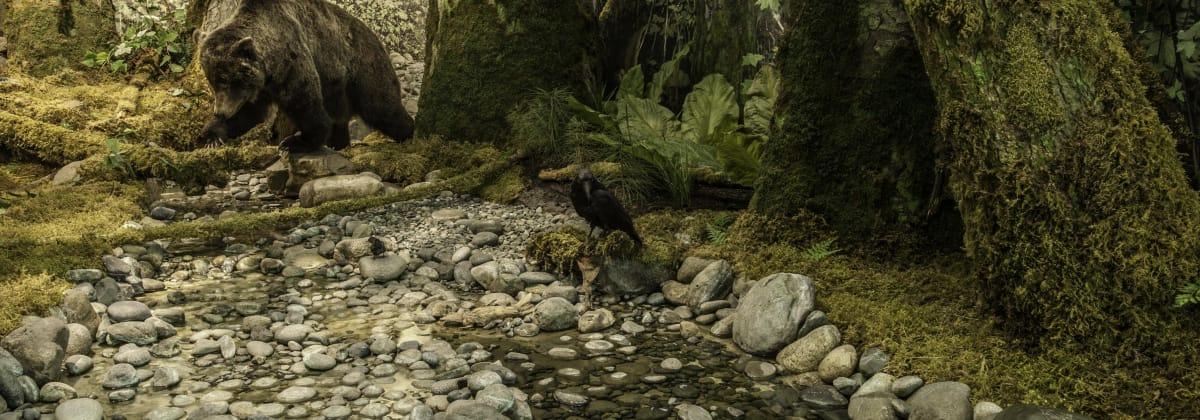

In this domed room, you enter the magnificent coast forest of British Columbia. You are surrounded by massive trunks of Sitka spruces, Douglas firs and western redcedars. Listen to the bird calls and an occasional elk “bugle”. Peek around the corner to the right and stare into the face of a cougar. Our heavy rain and nearness to the mild ocean waters support some of the tallest trees in the world.
The display portrays the forests from the warm dry hills of Vancouver Island to the misty cool northlands of Haida Gwaii. See arbutus and Garry oaks forming park-like stands on well-drained slopes and rocky outcrops. Growing around Victoria, this is one of Canada’s most threatened ecosystems. Heroic efforts are underway to restore some of these remaining stands and protect endangered species found nowhere else in Canada.
Where winter rain drenches the mountains, dense brooding forests of western redcedar, western hemlock and amabilis fir attain great heights.
Along the shoreline, especially that exposed to the fierce winds and pounding waves offered up by the Pacific Ocean, a narrow band of enormous Sitka spruce stands sentinel on shore.
On the left of the exhibit a beautiful stream trickles its way through the dense trees. Red alders grow where more sunlight can reach them. Year-round soil dampness encourages the skunk cabbage and devil’s club. A salmon carcass rots in the stream near a great bear. Every year, mature salmon migrate from the ocean, struggling up rivers and streams to spawn and then die, their bodies feeding upland animals and fertilizing our lush streamside forests.
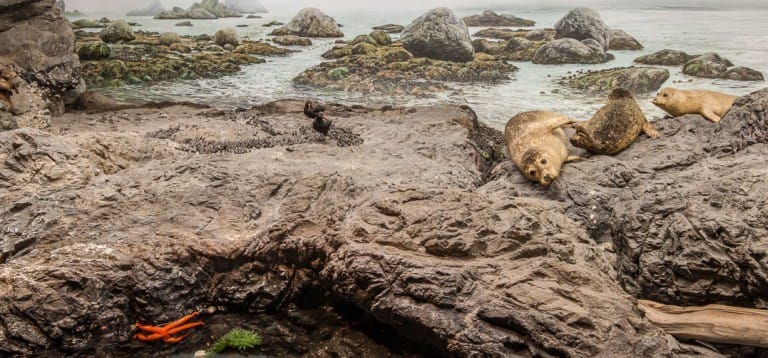
Peer into a tidepool and discover the spectacular diversity and richness of marine life that lives along British Columbia’s rugged seashores. Observe the colourful and the cryptic, as a variety of live animals—from anemones and snails to urchins and fishes—compete for food and shelter, each avoiding the threat of a hungry predator.
From the rocky beaches of Bamfield, continue along the outer coast, to the sandy shores of Long Beach and the wind-swept rocks of Triangle Island. Plants and animals that live on this coast are specially adapted to harsh, exposed conditions, where wind and temperature change rapidly. Stand in the shadow of one such iconic animal, the awe-inspiring Northern (or Steller’s) sea lion, and try to gauge your own relative size. Here’s a hint—as the largest of the “eared” seals, males may grow to four meters in length and over 1,000 kg in weight.
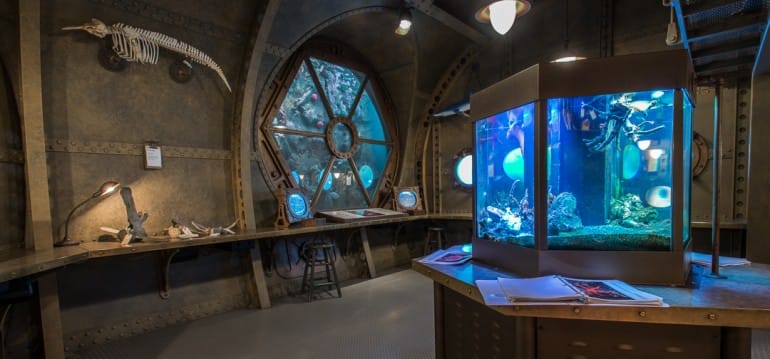
Experience the underwater world off of BC’s coast in a Victorian-era submarine. Similar to a Jules Verne story, this masterpiece exhibit is sure to capture your imagination with tales (and tails!) of mesmerizing marine life.
From the control room, view an underwater sea cliff stretching from floor to ceiling, or peer through portholes to witness the dynamic energy of a kelp bed. Conduct your own marine biology research by exploring the cabinets and drawers full of carefully preserved museum specimens, including stunning corals, crabs, shells, and sea stars. Or spend countless hours observing live animals—barnacles, hermit crabs, sea squirts, and fishes—as they eke out a living in our 360-litre aquarium. Finally, before resurfacing, be sure to check out the view through the periscope—see any sea monsters?
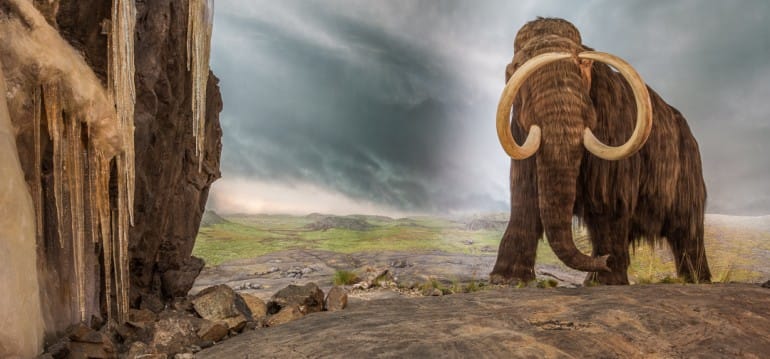
Travel to the distant past in the Green House-Ice House gallery. Gaze upward at a fantastic panorama of subtropical Vancouver Island. See spectacular palm and ammonite fossils from the land and sea when our region had a subtropical climate 80 million years ago.
In stark contrast, immediately ahead, see an icy landscape with a full-size mammoth calling to its kin. Feel the chill of the Ice Age as you near the great beast. Fossil mammoth tusks, mammoth and mastodon teeth and a giant bison skull fill a display case nearby and teach us of the ancient mega-fauna that once roamed British Columbia during the last stages of the Pleistocene Era. Look back and upward to a mural of the glacial landscape of alpine wildflower meadows that occurred around the hills of Victoria 17,000 years ago based on studies of fossil plants on southern Vancouver Island
Along the wall as you wander through this part of the gallery you follow the rise and fall of global temperatures and the coming and passing of beasts since before the passing of the dinosaurs. You can touch life-size replicas of fossils representing animals of the last 80 million years.
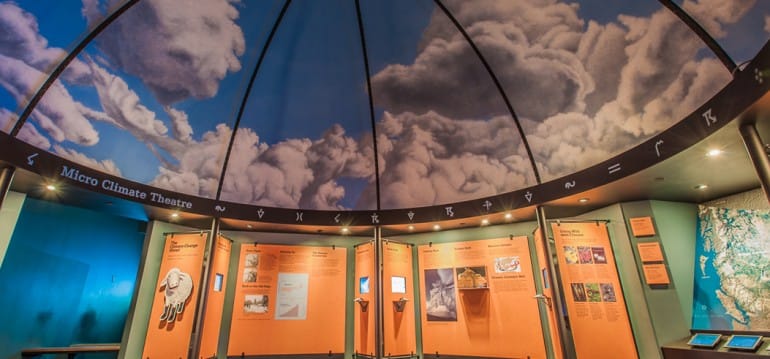
The Earth’s restless atmosphere has many surprises in store for us in the coming decades. In one of the first galleries ever built that explains how climate is changing as a consequence of global warming, you learn the differences between weather and climate. You get a sense of the diversity of BC’s remarkable climates and how they shape our landscape and ecology. Did you know that British Columbia recorded both one of the warmest and the coldest temperatures ever in Canada? One section of the exhibit explains how global climate varies in the short and long term and demonstrates that our climate is now warming rapidly.
You have an opportunity to use computer display terminals to look into the future with models in which you get to choose future scenarios of climate change. See the possible daily high and low temperatures and precipitation roll out over the next 90 years. In the gallery, you can see how ecosystems such as grasslands and species such as the iconic western redcedar may respond to the warming climates in our province. A display of the mountain pine beetle demonstrates one biological effect of climate change that is already occurring. Nearby display cases show plants and animals that may become more abundant such as the American badger and those like the Vancouver Island marmot that may be lost.
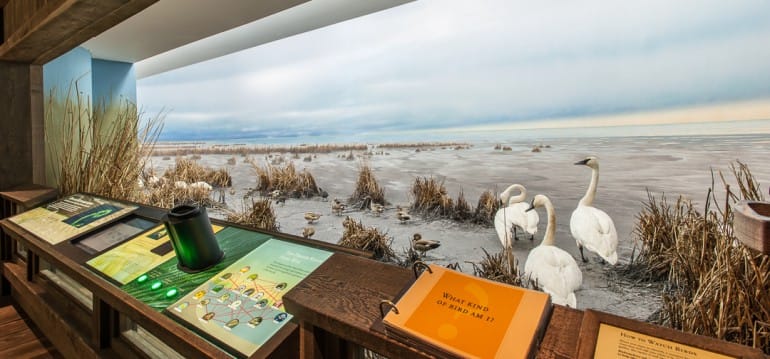
Stroll along the boardwalk to experience the sights and sounds of the Fraser River Delta. Remarkably, the Fraser River Delta is the largest estuary on North America’s Pacific coast, and yet represents one of the rarest ecosystems in the province.
Come explore the geography, geology, and ecology of this unique region, and discover an assortment of plants and animals that call this special place their home. The Fraser River Delta is a hotspot of biodiversity, from iconic Cattails to great White Sturgeon. And due to its rich productivity, the region hosts millions of migrating birds and fishes each year.
As you experience the Delta diorama, take a moment to improve your own bird-watching skills using our handy field guides and binoculars. Then investigate how the landscape has been shaped over geological time and continues to change today, as delta ecosystems are altered by agriculture, industry, and urban development. As a final test, take the Invader IQ challenge to learn about the spread of alien species in the region, and their impacts on the environment.